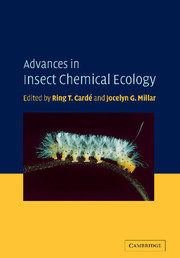Book contents
- Frontmatter
- Contents
- List of contributors
- Preface
- 1 Phytochemical diversity of insect defenses in tropical and temperate plant families
- 2 Recruitment of predators and parasitoids by herbivore-injured plants
- 3 Chemical ecology of astigmatid mites
- 4 Semiochemistry of spiders
- 5 Why do flowers smell? The chemical ecology of fragrance-driven pollination
- 6 Sex pheromones of cockroaches
- 7 A quest for alkaloids: the curious relationship between tiger moths and plants containing pyrrolizidine alkaloids
- 8 Structure of the pheromone communication channel in moths
- Index
- References
2 - Recruitment of predators and parasitoids by herbivore-injured plants
Published online by Cambridge University Press: 07 August 2009
- Frontmatter
- Contents
- List of contributors
- Preface
- 1 Phytochemical diversity of insect defenses in tropical and temperate plant families
- 2 Recruitment of predators and parasitoids by herbivore-injured plants
- 3 Chemical ecology of astigmatid mites
- 4 Semiochemistry of spiders
- 5 Why do flowers smell? The chemical ecology of fragrance-driven pollination
- 6 Sex pheromones of cockroaches
- 7 A quest for alkaloids: the curious relationship between tiger moths and plants containing pyrrolizidine alkaloids
- 8 Structure of the pheromone communication channel in moths
- Index
- References
Summary
Introduction
In recent years, induced plant defenses have received widespread attention from biologists in a variety of disciplines. The mechanisms underlying these defenses and the interactions that mediate them appeal not only to plant physiologists, ecologists, and evolutionary biologists but also to those scientists that search for novel strategies in plant protection. Several recent books (Karban and Baldwin, 1997; Agrawal et al., 1999) and reviews (Baldwin, 1994; Karban et al., 1997; Agrawal and Rutter, 1998; Agrawal and Karban, 1999; Baldwin and Preston, 1999; Dicke et al., 2003) have been devoted entirely to the subject of induced plant defenses. Various forces, ranging from abiotic stresses to biotic factors such as pathogens, arthropods, or higher organisms, may trigger different plant defense responses. Yet, the biochemical pathways that are involved appear to show considerable similarities. This is also true for the so-called indirect defenses.
The term indirect defense refers to those adaptations that result in the recruitment and sustenance of organisms that protect the plants against herbivorous attackers. The early published examples of indirect defenses involved intimate plant–ant interactions, in which myrmecophilous plants were shown to have evolved a range of adaptations providing ants with shelter (domatia) and various food sources (Belt, 1874; Janzen, 1966). In return, these plants may obtain a range of benefits because ants can provide nutrition (Thomson, 1981) or more commonly, protection against herbivores, pathogens, and competing plants (e.g. Koptur, 1992; Oliveira, 1997).
- Type
- Chapter
- Information
- Advances in Insect Chemical Ecology , pp. 21 - 75Publisher: Cambridge University PressPrint publication year: 2004
References
- 226
- Cited by



